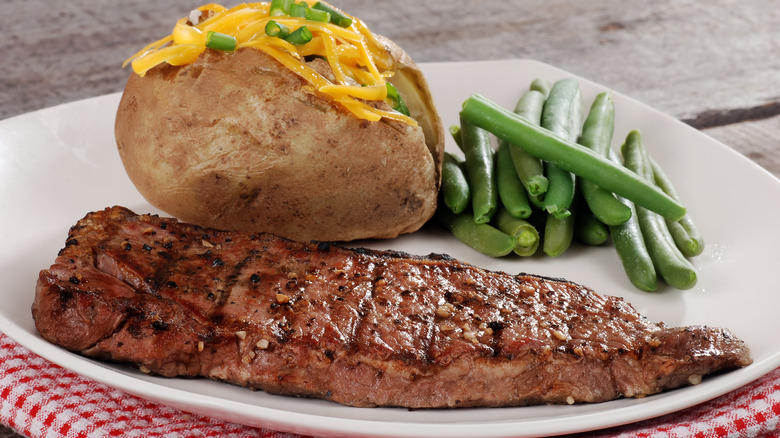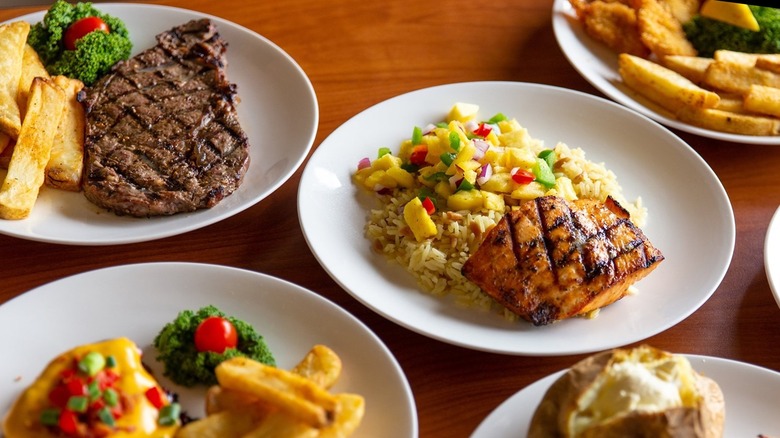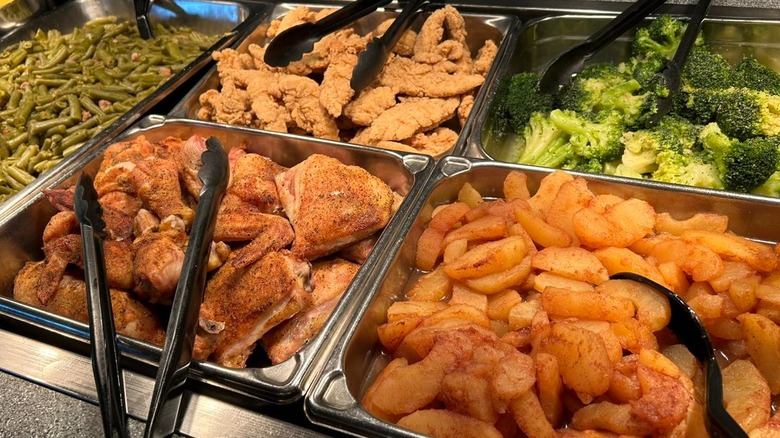Why Are Ponderosa Steakhouse Chains Shutting Down?
Buffets used to be all the rage in the U.S. — since their invention in the 1940s, they rose to their most popular point by the 1980s, but then started to decline dramatically by the end of the century. The Ponderosa Steakhouse buffet chain was one victim of this trend. A combination of internal financial woes, changing consumer preferences, overwhelming competition, and a severe loss in sales caused by the COVID-19 pandemic seem to have pushed the company towards failure. In fact, Food Republic rated it among the worst U.S. steakhouse chains in early 2024, yet this wasn't always the restaurant's reputation.
At one time, there were several hundred locations of Ponderosa Steakhouse, which was known for serving American comfort foods in Western-decorated dining rooms. It was founded in 1965 in Indiana and named after the fictional ranch from the television series "Bonanza" (themed restaurants were very trendy at the time). The prices may have been the greatest draw: A 1974 flyer advertised a Tuesday special of a ribeye steak, baked potato, and bread roll, along with the all-you-can-eat salad bar, for $2.59. Guests were encouraged to bring the whole family, and the restaurant had a penny-pinching no tipping policy.
Ponderosa did initially find financial success. Revenues more than tripled between 1968 and 1969, and it became the largest steakhouse chain in America by the 1970s. But the good vibes and affordable eats were not enough to override poor management and changing consumer culture.
Bad management sunk Ponderosa Steakhouse
In the 1980s, despite formidable sales, Ponderosa's funds were not managed very well, as the focus was on opening more restaurants instead of improving existing ones. Rising beef prices, an economic downturn, and ever-increasing competition from similar restaurants left Ponderosa in a precarious position.
At that point, there were more than 600 locations, and "corporate takeover entrepreneur" Asher Edelman bought a large percentage of Ponderosa's shares (via New York Times). He hoped to turn a profit quickly by cutting expenses, employees, and quality while raising prices. Simultaneously, he intended to leverage one of his other businesses to buy Ponderosa's meat processing subsidiary, but the deal failed due to a stock market collapse. Edelman sold Ponderosa to the Metromedia Restaurant Group in 1988, making it clear that his focus was on short-term profits instead of long-term success.
That same year, Metromedia also acquired Bonanza. Ponderosa was originally modeled after this chain, and there was serious competition between the two. Uniting the restaurants into "Ponderosa and Bonanza Steakhouses" was a resulting decision that seemed to make sense, but Ponderosa had already gone through numerous leadership hand-overs in a short period of time, and this purchase brought even more. Additionally, buffets were gradually becoming less attractive to customers. As such, Metromedia Restaurant Group filed for Chapter 11 bankruptcy in 2008, and restructured itself into Homestyle Dining LLC. The remaining 256 Ponderosa and Bonanza locales began closing. When the chains were purchased by Fat Brands Inc. in 2017, there were just 120 restaurants left.
Ponderosa Steakhouse suffered as Americans shied away from buffets
By 2019, there were only 75 Ponderosa and Bonanza restaurants open, and as of 2024, just 21 remain, with three noted as "temporarily closed," according to the restaurant's website. This demise may have been inevitable, as the restaurant industry was declining long before. The Great Recession of the 2000s left consumers with less to spend on going out to eat, and the restaurant groups behind chains like Old Country Buffet and Sweet Tomatoes filed for bankruptcy around the same time.
The idea of all-you-can-eat restaurants also became less desirable to consumers, especially younger generations. Though buffets aren't inherently "unhealthy," their reputation as excessive, gut-busting experiences conflicted with a cultural shift that favored more nutritious dining options. Buffets struggled to make pricing changes that gave them more revenue while still remaining cheap and attractive to customers, and dwindling demand could no longer support all of them. Finally, the COVID-19 pandemic — which stretched even the most successful restaurants to their financial limits — dealt a near-fatal blow.
However, some buffets have endured throughout the times. Hotel breakfast buffets are still objectively awesome, and there are plentiful options for great dining at the best buffets in Las Vegas. Even some nostalgic restaurants live on: Old-school buffets like Golden Corral adapted by modernizing their facilities, aesthetics, and offerings. While you may not be able to get your Ponderosa fix unless you live near one of the last few locations, it seems like its ilk are not yet a thing of the past.



